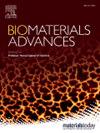rab27a介导的细胞外囊泡释放驱动星形细胞CSPG分泌和脊髓损伤中的胶质瘢痕形成
IF 5.5
2区 医学
Q2 MATERIALS SCIENCE, BIOMATERIALS
Materials Science & Engineering C-Materials for Biological Applications
Pub Date : 2025-05-19
DOI:10.1016/j.bioadv.2025.214357
引用次数: 0
摘要
外伤性脊髓损伤(SCI)通过损害神经元功能和造成神经胶质瘢痕来阻止轴突再生。来自星形胶质细胞的硫酸软骨素蛋白聚糖(CSPGs)驱动这一过程,但其释放机制(可能涉及细胞外囊泡(EVs))仍不清楚。Rab27a通过使多泡体(MVBs)与质膜对接和融合而释放ev。我们证实了Rab27a的表达和定位,随后用CD9、Alix和TSG101标记验证了EV的释放。rab27a介导的EV释放在rab27a诱导和rab27a - sirna处理的细胞中均得到证实。rab27a衍生的ev抑制神经元细胞生长,而Rab27a-siRNA衍生的ev促进神经元生长。本研究还观察到大鼠脊髓损伤模型中Rab27a表达上调。进一步分析显示,通过Rho/ROCK途径,在rab27a诱导的条件下,CSPG表达增加,pAkt和β-微管蛋白III水平改变。免疫组化证实CSPG/Rab27a/GFAP和CSPG/CD9在组织切片中共定位,证实Rab27a介导星形胶质细胞中含有CSPG的EV释放。这些发现表明Rab27a在CSPG通过ev释放和疤痕形成中起着至关重要的作用。Rab27a- sirna治疗显著改善了功能恢复,表明Rab27a是SCI中星形细胞疤痕调节的潜在靶点。该研究揭示了通过ev释放rab27a依赖性CSPG对挫伤性脊髓损伤亚急性瘢痕形成的详细机制。本文章由计算机程序翻译,如有差异,请以英文原文为准。
Rab27a-mediated extracellular vesicle release drives astrocytic CSPG secretion and glial scarring in spinal cord injury
Traumatic spinal cord injury (SCI) prevents axonal regeneration by impairing neuronal function and causing glial scarring. Chondroitin sulfate proteoglycans (CSPGs) from astrocytes drive this process, yet the release mechanism, potentially involving extracellular vesicles (EVs), remains unclear. Rab27a releases EVs from multivesicular bodies (MVBs) by enabling their docking and fusion with the plasma membrane. We confirmed Rab27a expression, and its localization, subsequently, EV release was validated with CD9, Alix, and TSG101 markers. Rab27a-mediated EV release was confirmed in both Rab27a-induced and Rab27a-siRNA-treated cells. Rab27a-derived EVs inhibited neuronal cell growth, while Rab27a-siRNA EVs promoted neuronal growth. Our study also observed upregulated Rab27a expression in the rat contusion model of SCI. Further analysis showed increased CSPG expression in Rab27a-induced conditions via the Rho/ROCK pathway, with altered pAkt, and β-tubulin III, levels. Immunohistochemistry confirmed CSPG/Rab27a/GFAP and CSPG/CD9 co-localization in tissue sections, verifying that Rab27a mediates EV release containing CSPG from astrocytes. These findings suggest that Rab27a plays a crucial role in CSPG release via EVs and scar formation. Functional recovery was significantly improved with Rab27a-siRNA treatment, suggesting Rab27a as a potential target for astrocytic scar modulation in SCI. The study reveals the detailed mechanistic insight of Rab27a-dependent CSPG release via EVs for sub-acute scar formation in contusion SCI.
求助全文
通过发布文献求助,成功后即可免费获取论文全文。
去求助
来源期刊
CiteScore
17.80
自引率
0.00%
发文量
501
审稿时长
27 days
期刊介绍:
Biomaterials Advances, previously known as Materials Science and Engineering: C-Materials for Biological Applications (P-ISSN: 0928-4931, E-ISSN: 1873-0191). Includes topics at the interface of the biomedical sciences and materials engineering. These topics include:
• Bioinspired and biomimetic materials for medical applications
• Materials of biological origin for medical applications
• Materials for "active" medical applications
• Self-assembling and self-healing materials for medical applications
• "Smart" (i.e., stimulus-response) materials for medical applications
• Ceramic, metallic, polymeric, and composite materials for medical applications
• Materials for in vivo sensing
• Materials for in vivo imaging
• Materials for delivery of pharmacologic agents and vaccines
• Novel approaches for characterizing and modeling materials for medical applications
Manuscripts on biological topics without a materials science component, or manuscripts on materials science without biological applications, will not be considered for publication in Materials Science and Engineering C. New submissions are first assessed for language, scope and originality (plagiarism check) and can be desk rejected before review if they need English language improvements, are out of scope or present excessive duplication with published sources.
Biomaterials Advances sits within Elsevier''s biomaterials science portfolio alongside Biomaterials, Materials Today Bio and Biomaterials and Biosystems. As part of the broader Materials Today family, Biomaterials Advances offers authors rigorous peer review, rapid decisions, and high visibility. We look forward to receiving your submissions!

 求助内容:
求助内容: 应助结果提醒方式:
应助结果提醒方式:


